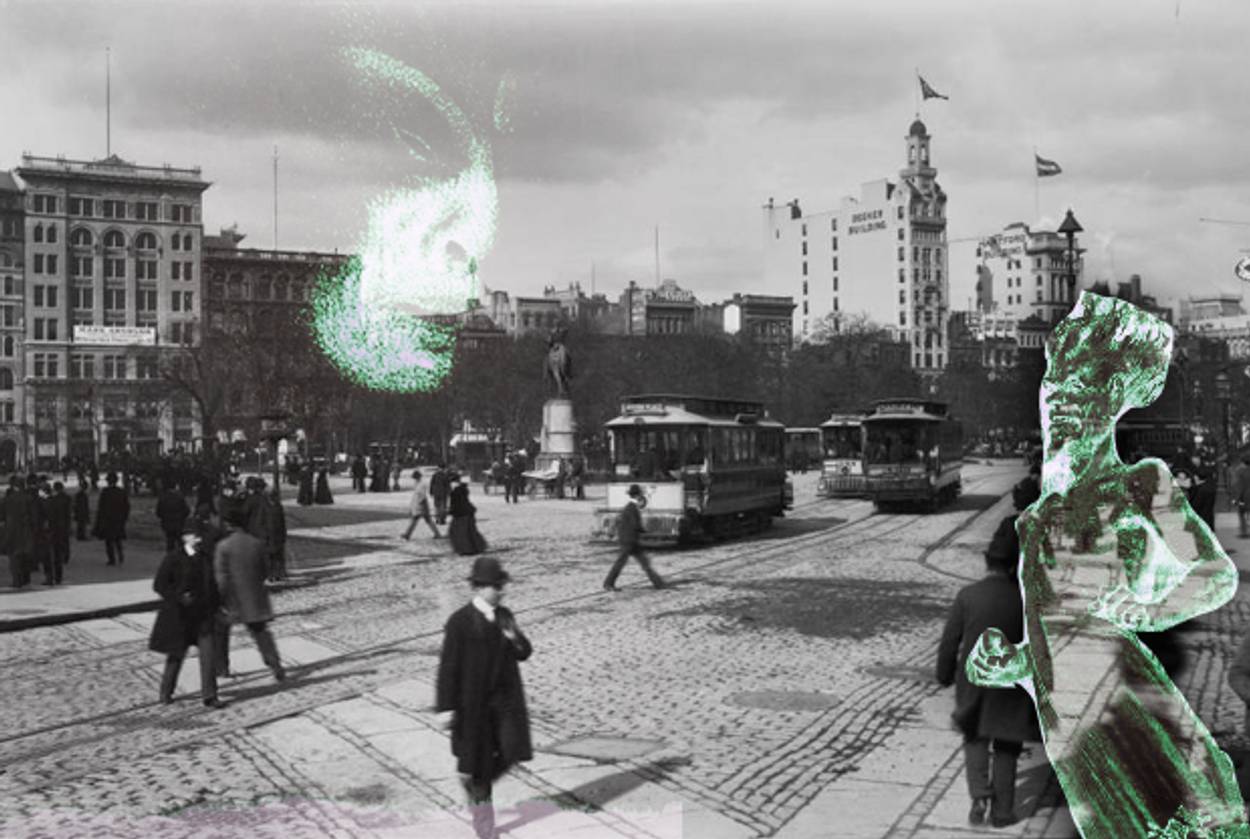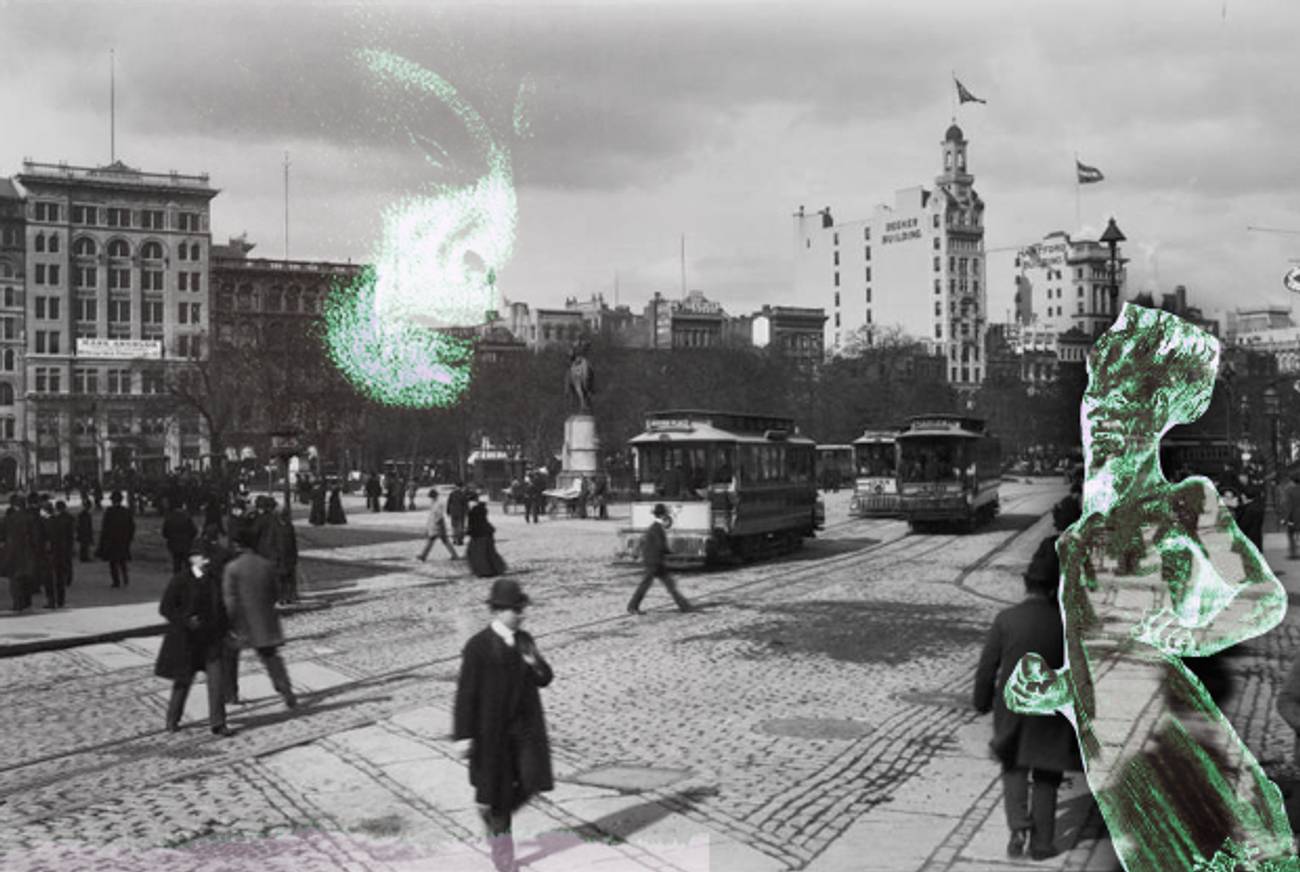Monster Mash
Helene Wecker’s new The Golem and the Jinni reads like When Harry Met Sally, if Harry and Sally were beasts




Like Alien vs. Predator or The Three Stooges Meet Hercules, the new novel The Golem and the Jinni announces its high-concept mash-up in its title. As promised, Helene Wecker’s debut, which is being published with much fanfare and in a beautifully produced edition, brings together supernatural creatures from two different mythical universes. The Golem, of course, is the homunculus of Jewish folklore, a powerful but erratic creature made of clay and brought to life through Kabbalistic magic. The Jinni is the lamp-dwelling, wish-granting spirit of Arabic myth, whose natural habitat is the desert. And where could these two utterly different beings meet one another? Why, only in America, of course, the land where the specific textures of tradition are ironed away into the comfortable drapery of nostalgia.
Wecker sets her novel in New York in 1899, at a time when immigrant Jews dominated the Lower East Side and a small colony of Lebanese and Syrian Christians made its home on the far west side, on Washington Street near the Hudson River. This was the great age of immigration, and the conceit of the novel is that both the Golem and the Jinni arrive in America as immigrants of a peculiar kind. Like new arrivals of the human species, they must figure out how to adapt to the pressures of American life; but for them, it’s also necessary to learn how to act convincingly human in the first place, so as not to give away their carefully hidden identities. It is a witty premise, though it remains underdeveloped, mainly because the novel’s immigrant New York setting is more a sepia stage set than a thoroughly imagined world.
Golems sometimes seem to be everywhere in contemporary Jewish fiction, from Michael Chabon’s The Amazing Adventures of Kavalier and Clay and Cynthia Ozick’s The Puttermesser Papers on down. The classical Golem story is the one about Rabbi Yehudah Loew, the Maharal of 16th-century Prague, who created the Golem to defend the Jewish community against attacks. But there is something deeply transgressive, in Jewish terms, about a human being trying to create life, and the story ends badly: the Golem runs amok and has to be destroyed, its lifeless body deposited in an attic, to be revived (like King Arthur) in the time of its people’s need. It makes perfect sense that precisely this story, out of all of Jewish folklore, should speak so directly to our imaginations today. The Golem story addresses our post-Holocaust fear of insecurity, our Zionist admiration of and guilt about strength, and our 21st-century obsession with technology and the ways it can go awry.
In Wecker’s hands, the Golem story becomes something quite different and appropriately enough much more American. The Golem in this novel is created in Eastern Europe by an evil Jewish sorcerer named Yehudah Schaalman, who makes her to be a bride for a lovelorn Jew on his way to America. On the crossing over, the husband-to-be uses a magic incantation to awaken his Golem-bride and then promptly dies of appendicitis. This leaves the Golem—who will eventually be given the name Chava—in a peculiarly American position: Intended to live as a servant in a hierarchical, traditional society, she is now a free agent, with no man to serve and nothing to guide her actions.
To complicate matters, Wecker gives Chava the power of telepathy, the ability to hear people’s thoughts. This gift, plus her supernatural strength, allow her to make her way in New York. But like Clark Kent or Peter Parker, Chava is a superhero in civilian clothing who must never allow the world to guess what she is really capable of. What’s more, she knows that as a Golem she has an inbuilt drive to violence: Let her perceive a danger to someone she loves, and she might go crazy and start killing. Luckily, she meets a kindly old rabbi, Avram Meyer, who figures out her secret and takes her in:
Confusion furrowed his brow—and then he laughed, without mirth. “Who made you?” he asked. “Was it your master?”
“No,” she replied, “I don’t know my maker.”
“Whoever it was,” he said, “was brilliant, and reckless, and quite amoral.”
This bit of dialogue is representative—smooth and portentous, it sounds like it comes from a movie, and The Golem and the Jinni as a whole reads like a movie in prose. Settings are evoked—Washington Square Park, a rich man’s uptown mansion, an East Side tenement—in terms that remind us of what we already know about such places, rather than creating them anew. The real emphasis is on the plot, which gets plottier as it goes along, until by the end of the book it explodes into a series of chase scenes and one-on-one combats.
Chava is Jewish, female, and made of earth. The Jinni—who is given the name Ahmad by his gentle human protector—is in every way her complement: Arab, male, and made of fire. He comes to America, naturally, in a magic lamp, and gets accidentally let loose by the metalsmith who is trying to repair it. The smith, Boutros Arbeely, is a Syrian Christian, and faced with a Jinni (described economically as “tall and well built, with handsome features”) he is as basically unruffled as Avram Meyer with his Golem. Arbeely introduces Ahmad to the community as his apprentice, and the Jinni—whose superpowers including the ability to control fire and heat metal with a touch—becomes known for his fine metalwork.
But, even more than the Golem, the Jinni is unhappy with his new American life. He is an ancient fire-spirit who was trapped in human form by another evil sorcerer, who bound him by means of an iron cuff. Because he is made of fire, he can be extinguished by water, which means he can’t go outside in the rain. Most of all, however, he misses the irresponsible freedom of the Jinni’s life in the desert, flying around in solitude and occasionally seducing human women for fun.
Inevitably, the Golem and the Jinni meet one night on the street, and each is automatically able to recognize the other. They form a partnership—neither romantic nor crime-fighting, as one might expect, but a sort of supernatural landsmanshaft, helping one another acclimate to their new lives. Chava goes to work in a bakery, where she is so mechanically efficient that she must force herself to make mistakes in order to pass for human. Ahmad makes tiny metal animals and then a whole decorated ceiling, which becomes the talk of Little Syria. And both end up in romantic entanglements with humans. Ahmad talks his way into the bed of Sophia Winston, a rich heiress (and a particularly thin character: “There was a high color in her cheek, a marvelous complement to her close-fitting burgundy gown”). Meanwhile, Chava, still unsatisfied without a master, gets married to Michael Levy, an agnostic do-gooder who runs a settlement house for Jewish immigrants.
It’s clear that The Golem and the Jinni has the potential to be a more literary novel than it finally wants to be. Chava’s predicament raises questions about female subservience and power; Ahmad, meanwhile, is a kind of Byronic supermale, unwilling to be tied down by duty or relationships. As both make their way in their immigrant milieu, Wecker has the opportunity to sketch what life was like for our ancestors, but she restricts herself to broad, familiar strokes: the ice-cream peddler, sleeping on balconies in hot weather, and so on. And psychology, almost by definition, has no place in a novel about magic monsters.
In any case, the novel’s more serious concerns are eventually lost as the action heats up. Without giving too much away, suffice it to say that the evil sorcerer who made the Golem and the evil sorcerer who captured the Jinni are connected; magic spells on ancient parchments are hidden and found; and good eventually triumphs. Socially, too, the message is a hopeful one. The division between Arab and Jew, so intractable in real life, becomes in fiction a mere difference in names: Both cultures are simply sources of folklore, colorful and full of magic—a sci-fi ecumenism. Wecker even leaves things open for a possible sequel—the Golem and the Jinni, like Harry and Sally, seem to be moving from friends to lovers. Surely their offspring, like the book itself, would be unstoppable.
***
Like this article? Sign up for our Daily Digest to get Tablet Magazine’s new content in your inbox each morning.
Adam Kirsch is a poet and literary critic, whose books include The People and the Books: 18 Classics of Jewish Literature.
Adam Kirsch is a poet and literary critic, whose books include The People and the Books: 18 Classics of Jewish Literature.